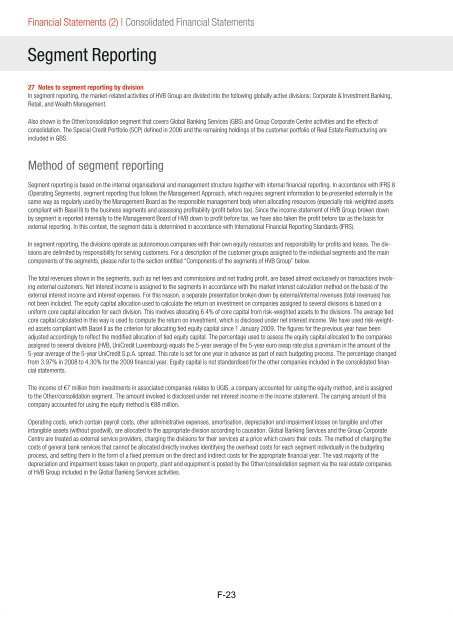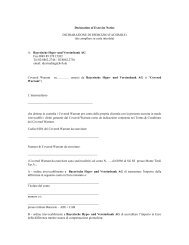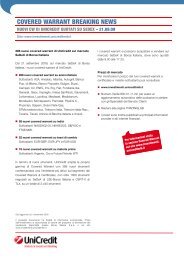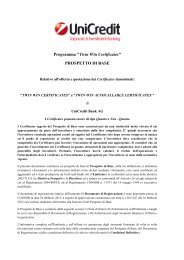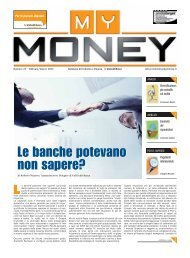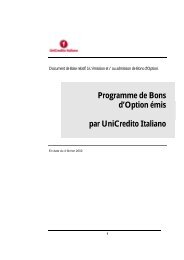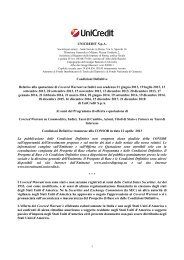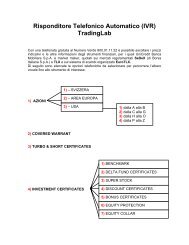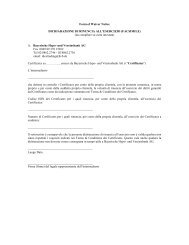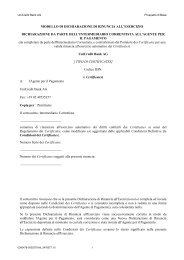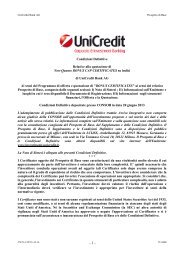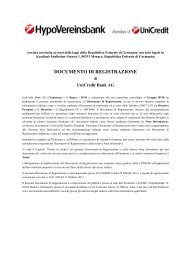UniCredit Bank AG
UniCredit Bank AG
UniCredit Bank AG
Create successful ePaper yourself
Turn your PDF publications into a flip-book with our unique Google optimized e-Paper software.
Financial Statements (2) | Consolidated Financial Statements<br />
Segment Reporting<br />
27 Notes to segment reporting by division<br />
In segment reporting, the market-related activities of HVB Group are divided into the following globally active divisions: Corporate & Investment <strong>Bank</strong>ing,<br />
Retail, and Wealth Management.<br />
Also shown is the Other/consolidation segment that covers Global <strong>Bank</strong>ing Services (GBS) and Group Corporate Centre activities and the effects of<br />
consolidation. The Special Credit Portfolio (SCP) defined in 2006 and the remaining holdings of the customer portfolio of Real Estate Restructuring are<br />
included in GBS.<br />
Method of segment reporting<br />
Segment reporting is based on the internal organisational and management structure together with internal financial reporting. In accordance with IFRS 8<br />
(Operating Segments), segment reporting thus follows the Management Approach, which requires segment information to be presented externally in the<br />
same way as regularly used by the Management Board as the responsible management body when allocating resources (especially risk-weighted assets<br />
compliant with Basel II) to the business segments and assessing profitability (profit before tax). Since the income statement of HVB Group broken down<br />
by segment is reported internally to the Management Board of HVB down to profit before tax, we have also taken the profit before tax as the basis for<br />
external reporting. In this context, the segment data is determined in accordance with International Financial Reporting Standards (IFRS).<br />
In segment reporting, the divisions operate as autonomous companies with their own equity resources and responsibility for profits and losses. The divisions<br />
are delimited by responsibility for serving customers. For a description of the customer groups assigned to the individual segments and the main<br />
components of the segments, please refer to the section entitled “Components of the segments of HVB Group” below.<br />
The total revenues shown in the segments, such as net fees and commissions and net trading profit, are based almost exclusively on transactions involving<br />
external customers. Net interest income is assigned to the segments in accordance with the market interest calculation method on the basis of the<br />
external interest income and interest expenses. For this reason, a separate presentation broken down by external/internal revenues (total revenues) has<br />
not been included. The equity capital allocation used to calculate the return on investment on companies assigned to several divisions is based on a<br />
uniform core capital allocation for each division. This involves allocating 6.4% of core capital from risk-weighted assets to the divisions. The average tied<br />
core capital calculated in this way is used to compute the return on investment, which is disclosed under net interest income. We have used risk-weighted<br />
assets compliant with Basel II as the criter ion for allocating tied equity capital since 1 January 2009. The figures for the previous year have been<br />
adjusted accordingly to reflect the modified allocation of tied equity capital. The percentage used to assess the equity capital allocated to the companies<br />
assigned to several divisions (HVB, <strong>UniCredit</strong> Luxembourg) equals the 5-year average of the 5-year euro swap rate plus a premium in the amount of the<br />
5-year average of the 5-year <strong>UniCredit</strong> S.p.A. spread. This rate is set for one year in advance as part of each budgeting process. The percentage changed<br />
from 3.97% in 2008 to 4.30% for the 2009 financial year. Equity capital is not standardised for the other companies included in the consolidated financial<br />
statements.<br />
The income of €7 million from investments in associated companies relates to UGIS, a company accounted for using the equity method, and is assigned<br />
to the Other/consolidation segment. The amount involved is disclosed under net interest income in the income statement. The carrying amount of this<br />
company accounted for using the equity method is €88 million.<br />
Operating costs, which contain payroll costs, other administrative expenses, amortisation, depreciation and impairment losses on tangible and other<br />
intangible assets (without goodwill), are allocated to the appropriate division according to causation. Global <strong>Bank</strong>ing Services and the Group Corporate<br />
Centre are treated as external service providers, charging the divisions for their services at a price which covers their costs. The method of charging the<br />
costs of general bank services that cannot be allocated directly involves identifying the overhead costs for each segment individually in the budgeting<br />
process, and setting them in the form of a fixed premium on the direct and indirect costs for the appropriate financial year. The vast majority of the<br />
depreciation and impairment losses taken on property, plant and equipment is posted by the Other/consolidation segment via the real estate companies<br />
of HVB Group included in the Global <strong>Bank</strong>ing Services activities.<br />
F-23<br />
110 2009 Annual Report · HypoVereinsbank


